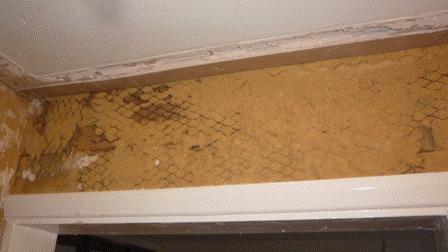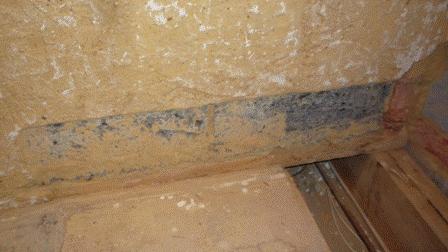Hi
I have almost prepared my sand/cement wall for tiling by hacking off the old skim coat. The sand/cement seems very well attached for 99% of the area. There are now a couple of problem areas, shown below.
The first picture is above the door. It is two very solid wooden battens covered by wire mesh, and the sand/cement on this has mostly come off. Depth relative to neighbouring sand/cement is about 10mm.
The second is an area at the bottom of a wall, with bare blockwork. Depth varies form about 8mm to 15mm.
Both areas are each no bigger than 90cm x 20cm. The tiles are 30x60, to be laid with the long edge horizontally. Tiles are pretty heavy, about 20Kg\sqm, but for these small areas I'm happy to take the risk with new basecoat etc rated at 20Kg/sqm (am aware grout and adhesive counts extra).
Just wondered how these areas are best prepared for tiling? I see 3 options ... room width is very tight, so boarding over is not an option.
1. Should I just leave it for the tiler, who may be able to build up layers using tile adhesive? Will that work on the wood/mesh?
2. I have a plasterer coming in anyway for the ceiling, should I ask him to hardwall it? Is 8mm too thing for this?
3. Or could I dot and dab some hardiebacker on for this small area? I am concerned that having part hardibacker,, part sand/cement could lead to cracking where the two join.
Thanks for any advice you can offer ..
I have almost prepared my sand/cement wall for tiling by hacking off the old skim coat. The sand/cement seems very well attached for 99% of the area. There are now a couple of problem areas, shown below.
The first picture is above the door. It is two very solid wooden battens covered by wire mesh, and the sand/cement on this has mostly come off. Depth relative to neighbouring sand/cement is about 10mm.
The second is an area at the bottom of a wall, with bare blockwork. Depth varies form about 8mm to 15mm.
Both areas are each no bigger than 90cm x 20cm. The tiles are 30x60, to be laid with the long edge horizontally. Tiles are pretty heavy, about 20Kg\sqm, but for these small areas I'm happy to take the risk with new basecoat etc rated at 20Kg/sqm (am aware grout and adhesive counts extra).
Just wondered how these areas are best prepared for tiling? I see 3 options ... room width is very tight, so boarding over is not an option.
1. Should I just leave it for the tiler, who may be able to build up layers using tile adhesive? Will that work on the wood/mesh?
2. I have a plasterer coming in anyway for the ceiling, should I ask him to hardwall it? Is 8mm too thing for this?
3. Or could I dot and dab some hardiebacker on for this small area? I am concerned that having part hardibacker,, part sand/cement could lead to cracking where the two join.
Thanks for any advice you can offer ..



